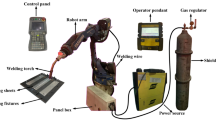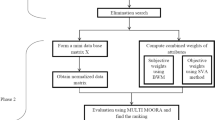Abstract
A methodology for evaluating different combinations of materials specifications for extreme environment applications is presented. This new approach addresses the materials selection problem using a multicriteria stringency level methodology that defines several thresholds obtained by analyzing different prediction models of irradiation embrittlement and hot cracking. To solve the conflicts among thresholds as provided by the different prediction models, a multiobjective approach is carried out. Materials for reactor pressure vessels have been considered as case study. It has been concluded that the best option to manufacture a pressure vessel for a pressurized water modern reactor is the selection of German manufacturing standards. Finally, a sensitivity analysis of the proposed methodology has been performed to evaluate the divergences between the single stringency level methodology and the new proposal including multicriteria decision making aspects.













Similar content being viewed by others
Abbreviations
- A ij :
-
Requirement i specified by the materials specification j
- A + :
-
Ideal solution
- A − :
-
Anti-ideal solution
- CF:
-
Chemical factor (R.G. 1.99 Rev.2 prediction model)
- C +j :
-
Relative closeness of each material requirement Rij to the ideal solution A +
- d +i :
-
Separation between the requirement i specified by the materials specification j (Aij) and the ideal solution according to the constraints
- d −i :
-
Separation between the requirement i specified by the materials specification j (A ij ) and the anti-ideal solution according to the constraints
- L i :
-
Distance between the solution provided by the upper bounds and the medium point or requirements range as established by multiobjective approach
- L s :
-
Standardized limit (method of stringency levels)
- RCC-MR:
-
French code
- r ij :
-
Normalized stringency level
- r j :
-
Mean value of r ij for the materials specification j
- SI i :
-
Sensitivity index of the output
- S + j :
-
The minimum Euclidean distance of any requirement of the materials specification j from the ideal solution
- S − j :
-
The maximum Euclidean distance of any requirement of the materials specification j from the anti-ideal solution
- SL ( Max) :
-
Maximum value of stringency level according to the defined scale
- T r :
-
Threshold
- Y p :
-
Yield point
- σ t , σ l :
-
Membrane theory stresses (transversal and longitudinal components)
- P:
-
Pressure (in-service)
- R, t:
-
Radius, thickness of vessel
- Φ :
-
Neutron flux (n/cm2)
- ∆RT DBT :
-
Shift of ductile-to-brittle transition temperature
- ASME B&PV:
-
American Society of Mechanical Engineers Boiler & Pressure Vessels
- DBT:
-
Ductile–Brittle Transition
- DV:
-
Decision variable
- erf:
-
Error function
- IASCC:
-
Irradiation-Assisted Stress Corrosion Cracking
- KTA:
-
Kern Technischer Ausschuss (German safety council)
- MCDM:
-
Multicriteria decision making
- OF:
-
Objective function
- PWR:
-
Pressure water reactor
- R.G.:
-
Regulatory guide (United States Nuclear Regulatory Commission)
- SL :
-
Stringency level
References
Amayev, A.D., Kryukov, A.M., Sokov, M.A.: Recovery of the transition temperature of irradiated WWER-440 Vessel Metal by Annealing. In: Steele, L.E. (ed.) Radiation Embrittlement of Nuclear Pressure Vessel Steels: An International Review, vol. 4, pp. 369–379. ASTM STP 1170 (1993)
American Society for Metals—ASM: Source book on stainless steels. Engineering Bockshelfs, Russell Township, USA (2012)
Arantes, F.M.L., Trevisan, R.E.: Experimental and theoretical evaluation of solidification cracking in weld metal. J. Achiev. Mater. Manuf. Eng. 20(1–2), 407–410 (2007)
ASME B&PV: Boiler and Pressure Vessels Code. American Society of Mechanical Engineers, New York (2015)
ASME B&PV II D App. 1 Mandatory, 2015: Basis for Establishing Stress Values. American Society of Mechanical Engineers, New York (2015)
ASTM E900: Standard Guide for Predicting Radiation-Induced Transition Temperature Shift in Reactor Vessel Materials. American Society for Testing and Materials, Philadephia (2002)
Ballesteros, A., Acosta, B.: Embrittlement Trend Curve for Vessel Steels with Low Copper Content. International Atomic Energy Agency, Vienna (1997)
Blagoeva, D.T., Debarberis, L., Jong, M., ten Pierick, P.: Stability of ferritic steel to higher doses: survey of reactor pressure vessel steel data and comparison with candidate materials for future nuclear systems. Int. J. Press. Vessel. Pip. 122, 1–5 (2014)
Bringas, J.E. (ed.): Handbook of Comparative World Steel Standards. American Society for Testing and Materials, Philadelphia (2000)
Brooks, A., Thompson, W.: Microstructural development and solidification cracking susceptibility of austenitic stainless steel welds. Int. Mater. Rev. 36, 16–44 (1991)
Chauhan, A., Vaish, R., Bowen, C.: Piezoelectric material selection for ultrasonic transducer and actuator applications. Proc. IMechE Part L J. Mater. Des. Appl. 229(1), 3–12 (2015)
Chung, H.M., Perry, D.L., Shack, W.J.: Sulphur in Austenitic Stainless Steel and Irradiation Assisted Stress Corrosion Cracking. NACE International, Houston (2003)
Eason, E.D., Wright, J.E., Odette, G.R.: Improved Embrittlement Correlations for Reactor Pressure Vessel Steels. NUREG/CR-6551. U.S. Nuclear Regulatory Commission, Washington (1998)
Fujii, K., Fukuya, K., Kasada, R., Kimura, A., Ohkubo, T.: Effects of stress on radiation hardening and microstructural evolution in A533B steel. J. Nucl. Mater. 407(3), 151–156 (2010)
Gillemot, F.: Overview of reactor pressure vessel cladding. Int. J. Nucl. Knowl. Manag. 4(4), 265–278 (2010)
Hyde, T., Sun, W.: Some issues on creep damage modelling of welds with heterogeneous structures. Int. J. Mech. Mater. Des. 5, 327–335 (2009)
IAEA: Earthquake Preparedness and Response for Nuclear Power Plants. International Atomic Energy Agency Publications, Vienna (2011)
Jenkins, M.L., Kirk, M.A., Pythian, W.J.: Experimental studies of cascade phenomena in metals. J. Nucl. Mater. 205, 16–30 (1993)
Jiang, C., Huang, X.P., Wei, X.P., Liu, N.Y.: A time-variant reliability analysis method for structural systems based on stochastic process discretization. Int. J. Mech. Mater. Des. 13, 173–193 (2017)
Kemp, R., Cottrell, G.A., Bhadeshia, H.K.D.H., Odette, G.R., Yamamoto, T., Kishimoto, H.: Neural-network analysis of irradiation hardening in low-activation steels. J. Nucl. Mater. 348(3), 311–328 (2006)
Kim, M.C., Park, S.G., Lee, K.H., Lee, B.S.: Comparison of fracture properties in SA508 Gr. 3 and Gr. 4N high strength low alloy steels for advanced pressure vessel materials. Int. J. Press. Vessel. Pip. 131, 60–66 (2015)
Kirk, M.: Development of the alternate pressurized thermal shock rule (10 CFR 50.61a) in the United States. Nucl. Eng. Technol. 45(3), 277–294 (2013)
Kobayashi, S., Yamamoto, T., Klingensmith, D., Odette, G.R., Kikuchi, H., Kamada, Y.: Magnetic evaluation of irradiation hardening in A533B reactor pressure vessel steels: magnetic hysteresis measurements and the model analysis. J. Nucl. Mater. 422(1–3), 158–162 (2012)
Kotecki, D., Sievert, T.A.: WRC-1992 Constitution diagram for stainless steel weld metal: a modification of the WRC-1988 diagram. Weld. J. 71, 171–178 (1992)
KTA Safety Standard 3201.1: Components of the Reactor Coolant Pressure Boundary of Light Water Reactors. Part 1: Materials and Product Forms. Nuclear Safety Standards Commission (KTA), Salzgitter (1998)
KTA Safety Standard 3201.3: Components of the Reactor Coolant Pressure Boundary of Light Water Reactors—Part 3: Manufacture. Nuclear Safety Standards Commission (KTA), Salzgitter (2007)
KTA Safety Standard 3203: Surveillance of the Irradiation Behaviour of Reactor Pressure Vessel Materials of LWR Facilities. Nuclear Safety Standards Commission (KTA), Salzgitter (2001)
KTA Safety Standard 3201.2: Components of the reactor coolant pressure boundary of light water reactors—Part 3: design and analysis. Nuclear Safety Standards Commission (KTA), Salzgitter (2011)
Kwon, J., Kwon, S.C., Hong, J.-H.: Prediction of radiation hardening in reactor pressure vessel steel based on a theoretical model. Ann. Nucl. Energy 30(15), 1549–1559 (2003)
Leite, M., Silva, A., Henriques, E., Madeira, J.F.A.: Materials selection for a set of multiple parts considering manufacturing costs and weight reduction with structural isoperformance using direct multisearch optimization. Struct. Multidiscip. Optim. 52, 635–644 (2015)
Miannay, D., Dussarté, D., Soulat, P.: The nil-ductility temperature shift arising from irradiation as predicted through the French test reactors experiments. Effects of radiation on materials. ASTM STP 1046, 284–304 (1990)
Milani, A.S., Shanian, A.: Gear material selection with uncertain and incomplete data. Material performance indices and decision aid model. Int. J. Mech. Mater. Des. 3, 209–222 (2006)
Moorhead, A.J., Sikka, V.K., Reed, R.W.: Effect of small additions of niobium on the welding behaviour of an austenitic stainless steel, properties of austenitic stainless steels and their weld metals (influence of slaight chemistry variations). ASTM Spec. Tech. Publ. 679, 103–111 (1979)
Moss, D., Basic, M.: Pressure vessel design manual. Butterworth-Heinemann, Oxford (2013)
Odette, G.R., Lucas, G.E.: Irradiation embrittlement of reactor pressure vessel steels:mechanism, models, and data correlations. Radiation embrittlement of nuclear pressure vessels steels: an international review. ASTM STP 909, 206–241 (1986)
RCC-MR: Design and Construction Rules for Mechanical Components of Nuclear Installations Applicable for High Temperature Structures and ITER Vacuum Vessel. AFCEN publications, Paris (2007)
Regulatory Guide R.G 1.99 Rev.1: Effects of Residual Elements on Predicted Radiation Damage to Reactor Vessels Materials. Nuclear Regulatory Commission (NRC), Washington (1977)
Regulatory Guide R.G 1.99 Rev.2: Radiation Embrittlement of Reactor Vessel Materials. Nuclear Regulatory Commission, Washington (1988)
Riou, B., Escaravage, C., Hittner, D., Pierron, D.: Issues in reactor pressure vessel materials. In: Proceedings of the 2nd International Topical Meeting on High Temperature Reactor Technology, pp. 10–22. Beijing (China), 22–24 Sept (2004)
Rodríguez, A., Camacho, A.M., Sebastián, M.A.: Prediction of the mechanical behaviour of cladding materials for nuclear reactor pressure-vessels based on the analysis of technological requirements. Proc. Eng. 100, 1301–1308 (2015)
Rodríguez-Prieto, A., Camacho, A.M., Sebastián, M.A.: Materials selection criteria for nuclear power applications: a decision algorithm. JOM 68(2), 496–506 (2016)
Rodríguez-Prieto, A., Camacho, A.M., Sebastián, M.A.: Selection of candidate materials for reactor pressure vessels: application of irradiation embrittlement prediction models and a stringency level methodology. Proc. IMechE Part L J. Mater. Des. Appl. (2017a). https://doi.org/10.1177/1464420717727769
Rodríguez-Prieto, A., Camacho, A.M., Sebastián, M.A.: Evaluation method for pressure vessel manufacturing codes: the influence of ASME unit conversion. Int. J. Mater. Prod. Technol. 54(4), 259–274 (2017b)
Rodríguez-Prieto, A., Camacho, A.M., Sebastián, M.A.: Quantitative analysis of prediction models of hot cracking in stainless steels using standardized requirements. Sadh. Acad. Proc. Eng. Sci. (2017c). https://doi.org/10.1007/s12046-017-0745-2
Sharifian, M.: Nonlinear elastoplastic analysis of pressure sensitive materials. Int. J. Mech. Mater. Des. (2017). https://doi.org/10.1007/s10999-017-9377-2
Soneda, N., Dohi, K., Nishida, K., Nomoto, A., Iwasaki, M., Tsuno, S., Akiyama, T., Watanabe, S., Ohta, T.: Flux effect on neutron irradiation embrittlement of Reactor Pressure Vessel steels irradiated to high fluences. In: Proceedings of the International Symposium on Contribution of Materials Investigations to Improve the Safety and Performance of LWRs, pp. 1–9. Avignon (France), 26–30 Sept (2011)
Timofeev, B.: Assessment of the first generation RPV state after designed lifetime. Int. J. Press. Vessel. Pip. 81(8), 703–712 (2004)
Valiente, M.A.: Predictive and measurement methods for delta ferrite determination in stainless steels. Weld. J. 91(4), 113–121 (2012)
Vijayaraghavan, V., Garg, A., Wong, C.H., Tai, K., Singru, P.M.: An integrated computational approach for determining the elastic properties of boron nitride nanotubes. Int. J. Mech. Mater. Des. 11, 1–14 (2015)
Welding Handbook: Materials and Applications Part 2, vol. 4, Nine edn. American welding society (AWS) publications, Miami (2014)
Wu, S.J., Cao, L.W.: Effect of intergranular failure on the critical fracture stress and the fracture toughness of degraded reactor pressure vessel steel. Int. J. Press. Vessel. Pip. 101, 23–29 (2013)
Author information
Authors and Affiliations
Corresponding author
Rights and permissions
About this article
Cite this article
Rodríguez-Prieto, A., Camacho, A.M. & Sebastián, M.A. Multicriteria materials selection for extreme operating conditions based on a multiobjective analysis of irradiation embrittlement and hot cracking prediction models. Int J Mech Mater Des 14, 617–634 (2018). https://doi.org/10.1007/s10999-017-9393-2
Received:
Accepted:
Published:
Issue Date:
DOI: https://doi.org/10.1007/s10999-017-9393-2




